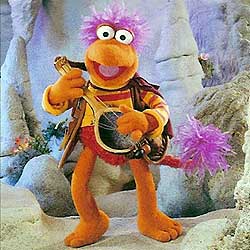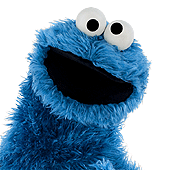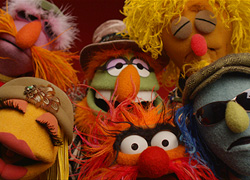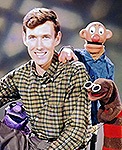TV Guide.com's "Ask the Televisionary"
Here is the full text...
"Question: Could you tell me the name of Kermit the frog's nephew and the name of Miss Piggy's dog? My wife doesn't believe that Kermit has a nephew and Miss Piggy has a pet. Please let me know their names so that I can tease her. — Ricardo B., Reading, Pa.
Televisionary: So this is what my column has come to, Ricardo — complicity in your domestic-warfare campaign? Shall I next confirm for your kids that Santa doesn't actually exist?
Aaaaah, who am I to judge? I'm the guy who, despite my claims of adulthood, still insists on squeezing my hands together to make gross bodily-function noises until my wife screams. So tease away, for Kermit did indeed have a nephew named Robin, while Miss Piggy had a pooch named Foo-Foo.
And it was just such minor characters that made the show so brilliant. The Swedish Chef, Statler and Waldorf, Dr. Teeth, Animal, the chickens, the rats — those supporting players fleshed out an already robust cast of characters, which included such feature performers as the aforementioned Kermit and Miss Piggy, Gonzo, Rowlf and Fozzie Bear.
During the show's 120-episode syndicated run from 1976-81, Henson and company utilized three basic types of Muppet: a one-person design, where the puppeteer merely inserted his or her right hand up into the mouth and used the other to manipulate the Muppet's movable left arm (the right arm was usually stationary); a two-person version where a second puppeteer worked the character's right arm and any other needed props; and big guys like the giant monster Sweetums, whose puppeteer was inside the costume.
It took a three-person team of art director, puppeteer and builder to design and make a Muppet, using a variety of ears and noses to build one of 15 different forms into hundreds of characters. But it was the puppeteer who breathed life into each Muppet and transformed sound craftsmanship into something more magical. The late Jim Henson, who died in 1990 and was the driving force behind the whole operation, claimed the secret was matching performer to character. A proper fit, Henson told TV Guide in 1977, called for someone who'd walked the walk. "[Puppeteer] Dave Goelz did a character called Zoot on The Muppet Show. Sort of an aging hippie musician," he said by way of example. "And Dave couldn't relate to Zoot, he couldn't ad-lib the role. On the other hand, I could have done Zoot easily. I used to play the piano on The Muppet Show, one of the things I do best is arranging the musical numbers. I can identify very easily with an aging hippie musician."
That he could, and so could the others who brought the Muppets to life. Well enough, in fact, that when Henson or one of his colleagues went to work, people tended to forget they weren't actually watching or talking to a live being. "A Muppet, when you get down to it, is somebody's arm in a piece of cloth," TV Guide reviewer Robert MacKenzie wrote in 1978. "But Jim Henson and his puppeteers invest their little characters with love, which is the same as making them live."
Many a guest could attest to that. Alice Cooper recalled in an interview how easy it was to get lost in the moment. "The funny thing was that... you're rehearsing with the puppets," he told The Onion A.V. Club. "And you're talking to the puppets, not realizing that there's a guy down below you and you're talking to his hand. So you're sitting there, and Kermit's going, 'Well, Alice, um, should I move over here a little bit?' And I'm going, 'Yeah, yeah, Kermit. I'll tell you what: The arrow's gonna come right through here, and I don't want it to get too close to you.' And he's like, 'Oh, I don't want to get hit with it...' And after a while, I'm going, 'What am I doing?!' I look down, and there's the guy down there, and I'm like, 'Why am I talking to your hand?' And I realized that I really was rehearsing with the character."
It was that knack for drawing people in that got Henson noticed when he put together Sam and Friends, a five-minute local spot that ran locally in Washington, D.C., before The Jack Paar Show in the late '50s. In 1959, the spot was up for an Emmy. In '63, he was working on The Today Show and between that, commercial production and Sesame Street, the operation took off into hit TV shows and features. Even after Henson's death, his son Brian has had no small amount of success (The Sci Fi Channel's current cult hit Farscape is just one feather in the Henson company cap).
All of which goes to show what a little vision can do. "[T]here's a great potential for puppetry on TV [that I haven't] explored yet," Henson said in 1970, six years before his creations graduated into working their own show. He didn't know the half of it."
http://tvguide.com/tv/televisionary/
- Billy


 Welcome to the Muppet Central Forum!
Welcome to the Muppet Central Forum! Back to the Rock Season 2
Back to the Rock Season 2 Sesame Street Season 54
Sesame Street Season 54 The Muppets Mayhem premieres
The Muppets Mayhem premieres Bear arrives on Disney+
Bear arrives on Disney+ Sam and Friends Book
Sam and Friends Book
 WOW, what great attention!
WOW, what great attention! 